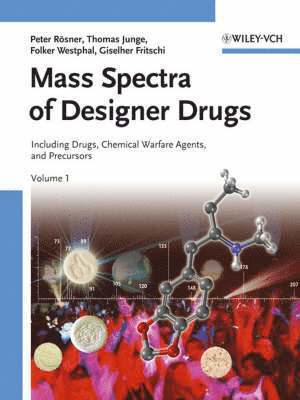
- Format
- Inbunden (Hardback)
- Språk
- Engelska
- Antal sidor
- 2087
- Utgivningsdatum
- 2007-01-01
- Upplaga
- 11
- Förlag
- Blackwell Verlag GmbH
- Illustrationer
- Illustrations
- Dimensioner
- 358 x 269 x 226 mm
- Vikt
- Antal komponenter
- 2
- Komponenter
- 2 Hardbacks
- ISBN
- 9783527307982
- 6623 g
Mass Spectra of Designer Drugs, 2 Volume Set
Including Precursors, Medicinal Drugs and Chemical Warfare Agents
Kundrecensioner
Recensioner i media
"Anyone working in mass spectrometry where one of these databases is applicable will be well advised to consider its addition to their tool kit for identification and confirmation." (J Am Soc Mass Spectrom, 2011) "...the content of this compact, well-organized, and concise publication will be of tremendous use to clinical and forensic toxicologists as well as researchers." (Journal of Forensic Science, November 2007) "It is very rich in information guidebook, which will be useful support for young scientists...but also for specialists..." (International Journal of Biological Macromolecules, 41/2007)
Övrig information
Peter Rosner (born 1944) studied Chemistry at the University of Kiel (Germany). In 1981 he became head of the toxicology department at the state agency of criminal investigation (Landeskriminalamt) in Kiel, where he focuses on drug identification and structure elucidation with GC/MS methods. Since 1992 he has also been a lecturer for mass spectrometry at the University of Kiel. In 2005, Dr. Rosner received the Jean-Servais-Stas Award from the Society of Toxicological and Forensic Chemistry in honor of his outstanding work in forensic sciences. Thomas Junge (born 1959) studied Technical Chemistry at the University of Applied Science of Lubeck (Germany). Since 1985 he has been a specialist for daughter ion mass spectroscopy in the toxicology department at the Landeskriminalamt in Kiel. His contribution was essential in building a mass spectral daughter ion data base for the structure eludication of new designer drugs. Folker Westphal (born 1965) studied Chemistry at the Universities of Hannover and Kiel (Germany), and also holds a degree as Special Chemist for Toxicology from the University of Leipzig. From 1999 to 2004 he worked at the Institute of Legal Medicine in Kiel as forensic scientist. Since 2004 he is leader of the section "Analysis of Drugs of Abuse and Forensic Toxicology" at the Landeskriminalamt in Kiel. Giselher Fritschi (born 1944) studied Chemistry at the Universities of Mainz and Karlsruhe (Germany). After a postdoc year at the University of Marburg he joined the Bundesgesundheitsamt (Federal Health Office) in Frankfurt. In 1978 he changed to the Landeskriminalamt in Wiesbaden as forensic expert for toxicological analysis, focusing on the structure elucidation of new designer drugs.
Innehållsförteckning
The collection contains 8800 records obtained from 4379 compounds from the following categories: - designer drugs - medicinal drugs - chemical warfare agents - explosives Each record contains the following data: - full or expanded mass spectrum (150 peaks on average) - IUPAC name, WHO name (if any) - synonyms and proprietary names - legal category information according to United Nations, U.S.A. and German standards - information on therapeutic and illicit modes of use - structural formula - molecular formula and exact molecular weight - CAS number - GC retention index (measured or calculated) - information on recording conditions - spectrum quality index (according to McLafferty) and verification index (matching with spectra from other published collections)
Du kanske gillar
-
Hidden Spring
Mark Solms
B Format Paperback -
Orbital
Samantha Harvey
Häftad -
Shift
Ethan Kross
Häftad
